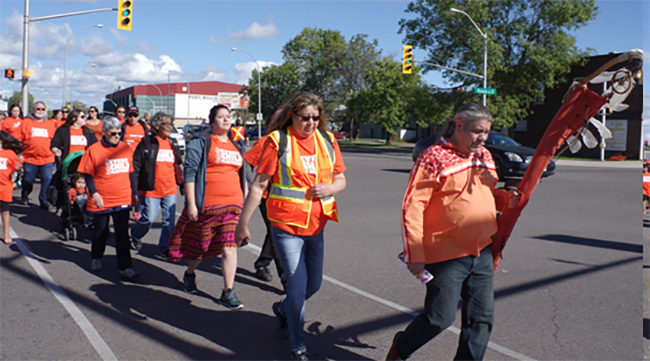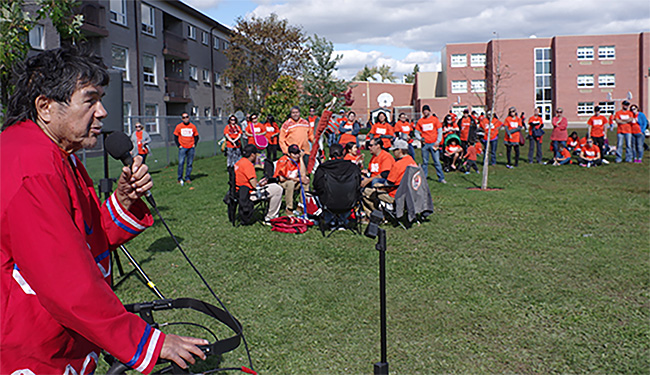Residential School Survivor shares experience during Orange Shirt Day walk in Thunder Bay


By Rick Garrick
THUNDER BAY – Former Long Lake #58 chief Allen Towegishig shared his experiences at St. Joseph’s residential school during Nishnawbe Aski Nation’s fourth annual Orange Shirt Day walk in Thunder Bay.
“When I first came here I was seven years old,” says Towegishig, who attended St. Joseph’s for three years beginning in 1951. “The first thing they taught us was don’t speak the language. If they caught you speaking Anishinabemowin, they would put soap in your mouth.”
Towegishig says he became “very lonely, very sad and depressed” at residential school.
“We couldn’t talk to our brothers and sisters,” Towegishig says, noting that his family was very close before they were sent away to residential school. “As soon as we came to the school we were separated.”
Towegishig says he was also told that the Anishinabe were “no good” when he went to residential school.
“After that I was ashamed to be Anishinabe and I didn’t want to be one,” Towegishig says. “I used to cry a lot. And I used to wet my bed a lot. And if you wet your bed a lot, they made you walk around with a diaper.”
Towegishig says he is now proud to be an Anishinabe person after going on a healing journey in 1974, where he learned more about the Anishinabe culture and ceremonies.
“That’s where I got my Anishinabe name,” Towegishig says. “My Anishinabe name is Miinodin, Gentle Wind.”
Fort William Chief Peter Collins raised the story about how residential school survivor Phyllis (Jack) Webstad had her new orange shirt, which her grandmother had bought for her, taken away on her first day at residential school during his opening comments for the kick-off of the Orange Shirt Day walk at Paterson Park. Orange Shirt Day was named in recognition of Webstad.
“She went to residential school with her orange shirt on and when she got to that school, they took away that shirt,” Collins says. “And as she grew older and wiser and with more teachings, she brought this teaching alive and brought the orange shirt to what it is today. Today is the fifth year I believe of the Orange Shirt movement and the work we have to do together. We always say to all Canadians, it doesn’t matter what race you come from, all of our children matter, all of our children are important to us, all of our children are our future and our next generation.”
Thunder Bay Councillor Frank Pullia, Thunder Bay-Rainy River MP Don Rusnak and NAN Deputy Grand Chief Anna Betty Achneepineskum also spoke at Paterson Park. The walkers then proceeded along Miles St., Vickers St. and Arthur St. to Pope John Paul II Elementary School, the former site of St. Joseph’s residential school, where a ceremony was held for the recently installed monument, which is made from Ruby Lake marble from the Red Rock Indian Band’s quarry.
Ron Morrisseau, a St. Joseph’s residential school survivor, says his experience at residential school still “hurts a lot.”
“I feel a lot of pain when I see this,” Morrisseau says. “It’s something I wanted to forget, but it seems that I can’t forget about it. And I don’t think I ever will. I spent nine years in that school, and it’s something that I can’t forget. Right now it’s hurting.”
Morrisseau says he didn’t like residential school when he was a student and he still doesn’t like it.
“But I have to suffer the consequences,” Morrisseau says. “I have to pay for the mistakes of the people who made it.”


